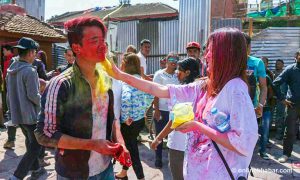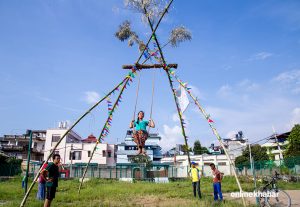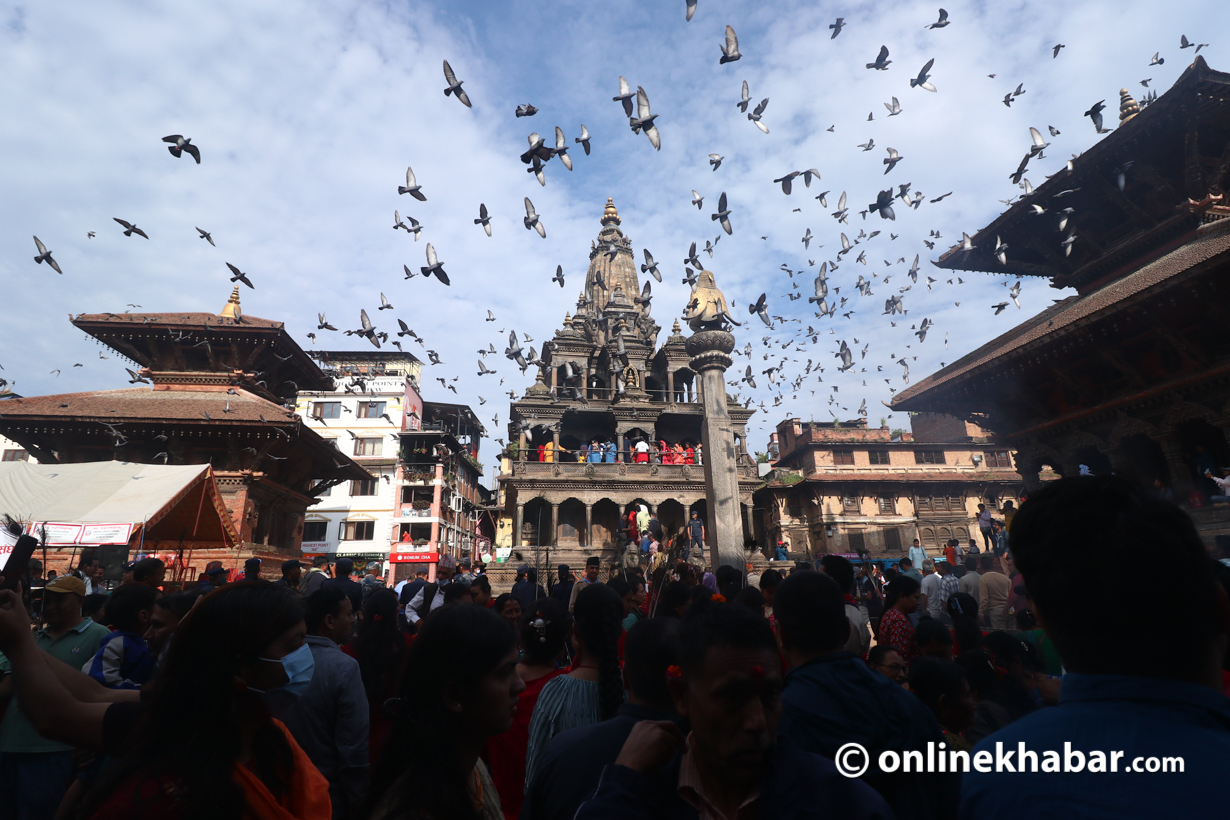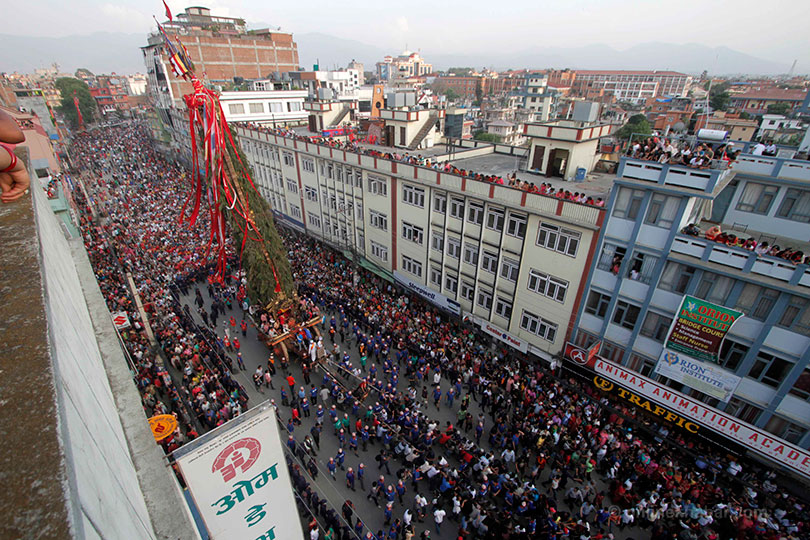
Kathmandu, the city of festivals, has many interesting legends, myths or stories behind each of its unique jatras (festivals), adding colours to the celebration. But the same stories that give context to the traditions also gave rise to controversies.
Recently, a similar rift started between the two cities–Lalitpur and Kirtipur–of the valley. The reason was the installation of two idols— Rato Machhindranath and Yaaka Misaa— at the foot of the Uma Maheshwar temple in Pyanga Thaa of Kirtipur municipality. The two idols of Karunamaya (Rato Machchindranath) and Yaaka Misaa, believed to be his consort or lover, were installed on the northern wall of mythological rock at Pyanga Thaa, facing south.
So what is this debate all about?
Growing debate

With the initiative of the local organisation, Sukhi Ga Chhen Samaj, the two idols were installed on December 1, 2022. The idols were made based on the stories about Rato Machhindranath and the devoted, loving female known as Yaaka Misaa and installed in the location where the two made vows to meet every year before the chariot festival started.
But it ignited unprecedented friction between the two cities–Kirtipur and Lalitpur–of the valley, which is growing bigger now as Hyagrib Bhairavnath and 32 Paneju Sangh of Lalitpur announced that they would not participate in the ongoing Rato Machhindranath chariot festival and will not accept the prasad (offerings) from the chariot as per the age-old tradition.
Every year, from the Thatitol of Lalitpur, as a representative of the Rato Machhindranath, a paneju (priest) walks barefoot to Kirtipur to give offerings to Yaaka Misaa. Four days before the Rato Machhindranath’s chariot festival commences, there is a tradition that priests sit on the patio made at Sohrakhute in Mangal Bazaar. After looking at the stars and their astronomical calculations, they decide an appropriate sait (auspicious time) for jalpaneju to take the prasad to Yaaka Misaa in Kirtipur.
The two local organisations had been protesting against the installation of the Rato Machhindranath and Yaaka Misaa idols since the start. But, close to the chariot festival, when Sukhi Ga Chhen Samaj did not agree to remove the idols, the two organisations decided not to be a part of the tradition until the idols are removed. And with the break in age-old tradition, cultural experts, historians and other locals are growing concerned about the future.
Kirtipur Mayor Raj Kumar Nakarmi says he had formally asked the Sukhi Ga Chhen Samaj to remove the idols, but it refused, maintaining its stand that the idols were first made and installed in consultation with the Paneju Sangh.
Now, he is worried that the tension will also give rise to disharmony between the two cities of the valley. “No matter how hard we tried, we have not come to an agreement. We hope there will not be a rift between the two cultural cities.”
According to Narayan Maharjan, the general secretary of the Sukhi Ga Chhen Samaj, his organisation is prepared to adopt flexibility to a certain extent for the continuation of the tradition of bringing prasad. “We are not in favour of stopping the traditions we have followed for hundreds of years, the Paneju Sangh should talk to us, then only can we conclude what can be done to bring prasad. We will think about removing the idols but there should be peaceful dialogues not threats or attempts of intimidation.”
Maharjan informs that discussions were also held with the Department of Archaeology, municipalities and the Paneju Sangh while installing the idols of Rato Machhindranath and Yaaka Misaa in Pyanga Thaa.
“No one protested when the idols were installed, but now there is a protest. We welcomed the idols with much fervour, and now, what will be the point of all that if we are to remove the idols just like that? Should not the residents of Kirtipur also be given respect here?”
Dissident voices
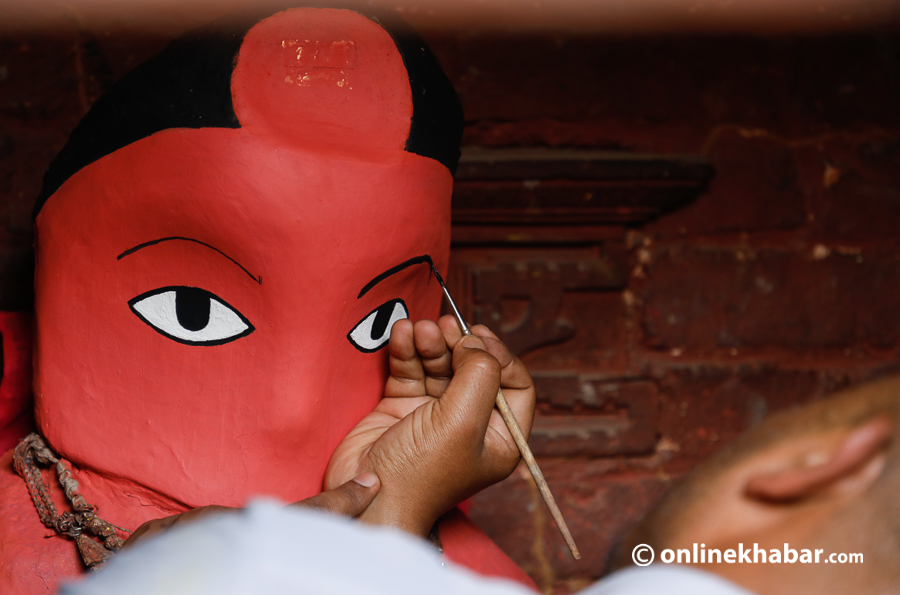
Meanwhile, 32 Paneju Sangh has been saying that the idols should not be installed anywhere. Immediately after the installation of the idols, Hyagrib Bhairavnath and 32 Paneju Sangh issued a statement expressing their disagreement on December 5, 2022. The president of 32 Paneju Sangh, Yagya Ratna Shakya, says that the organisation never gave written consent.
Over the dispute, the organisation gave a memorandum to Guthi Sansthan on December 7, 2022. On December 18, 2022, it announced that it would not accept the prasad until the idols of Rato Machhindranath and Yaaka Misaa were removed. Even on Monday, April 24, the Paneju Sangh issued a statement reiterating its stance.
Shakya says, “A replica of the Machchindranath idol cannot be installed in any other place except in Lalitpur. If two statues of Machchindranath cannot be installed, and with an extension, there cannot be an idol of Yaaka Misaa. Until our demand is addressed, we will not take prasad to Kirtipur.”
Shakya argues that the tradition has continued without the idols there for about 1,600 years ago. The new development, he argues, has given rise to confusion among people about Rato Machchindranath and the goddess Yaaka Misa, who is taken as the form of shakti (power) in the historical and religious place.
The story of prasad for Yaaka Misaa
As per the myth, it is said that King Narendradev of Bhaktapur, tantric master Bandhudatta of Kathmandu, Rathchakra jyapu of Lalitpur and Karkotak Nagaraj of Taudaha together brought the Rato Machhindranath idol from Kamakhya Peeth based in Assam, India, and started the chariot festival, thus, bringing rain to the Kathmandu valley.
The myth goes that a severe famine that lasted for 12 years ended upon the arrival of the god. Then, in the field, the paddies began to sway representing the prosperity that came with the idol, the god of rain. Then also began the chariot festival.
People from Assam, Kathmandu, Bhaktapur, Kirtipur and Lalitpur, who were involved in the process, started conducting various chariot festivals under their own names, except for one–Karkotaka. When they were on their way to take the idol, Karkotaka Nagaraja of Taudaha helped others cross the river by taking a form of a bridge. So, without him, it would have been almost impossible for others to bring the idol to Kathmandu. It is said Acharya Bandhudatta made him join the team realising this very information.
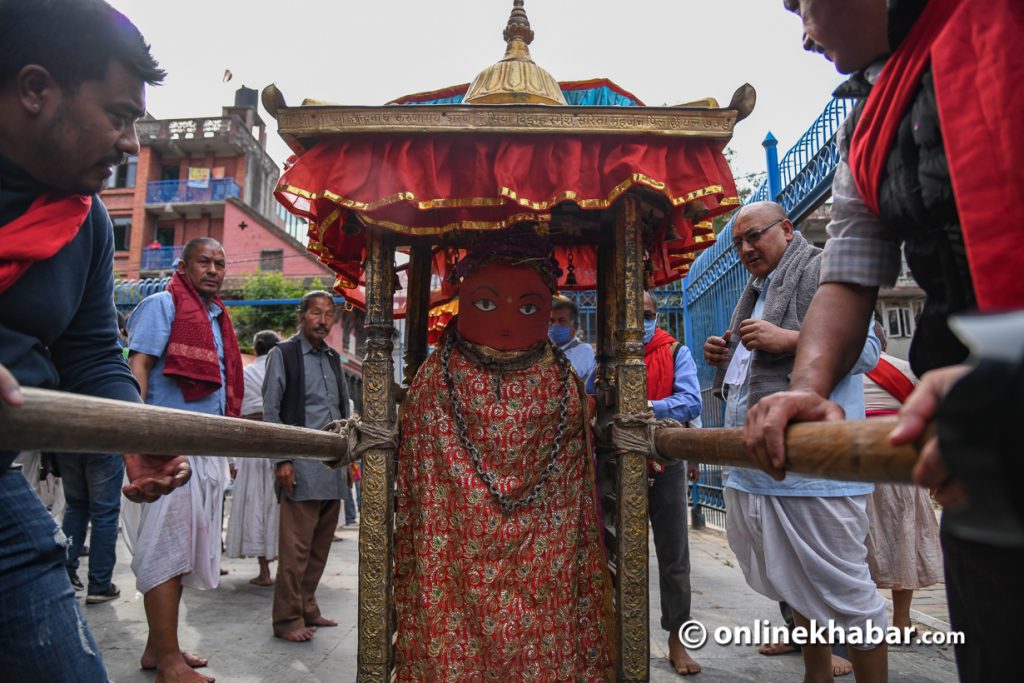
In spite of his role, when no jatra was held under his name, Karkotak Nagaraj got angry for being left out. He managed to control his anger, but his wife, Nagarani, could not control her anger. While the jatra was going on, she disguised herself as a human and reached Thatitol of Lagankhel to take the Rato Machhindranath idol with her.
The next day, after dropping the tradition of dropping a coconut from the chariot, Nagarani tried to pull Machhindranath’s chariot with her full strength and take it away. No one dared to challenge her or her power first.
But Acharya Bandhudatta stopped the chariot from moving with his tantric power. And no matter how hard Nagrani pulled, the wheels of the chariot tied to Bandhudatta’s tantric spells did not budge. When Nagrani felt she would not succeed, she tricked Bandhudatta and took one of the deity’s 32 traits and fled away.
Nagrani wanted to go straight to Taudaha and disappear. Had that happened, it would have been impossible to search for her and bring back what she stole. It was again thanks to Acharya Bandhudatta and his tantric knowledge that he deceived Nagrani into climbing the hill of Kirtipur, and did not let her go to Taudaha.
Nagrani arrived at Pyanga Thaa in Kirtipur all tired. Acharya Bandhudatta followed her there and persuaded Nagrani into giving the stolen trait back, saying, “Oh Nagrani, the glory of Rato Machhindranath will be incomplete even if there is just one trait missing. So please return it to me.”
But, Nagarani did not agree.
Seeing Nagrani, Bandhudatta proposed, “Oh Nagrani, if you return that, I promise that every year the chariot festival from Lagankhel to Jawalakhel will be in the name of Kirtipur. And I will bring the prasad and offer it to a kumari or Yaaka Misaa (virgin girl) too.”
Honouring the tradition, and harmony of the two cities, girls from Kirtipur also reach Lalitpur to pull the chariot from Lagankhel as another part of the tradition called Yaaka Misaaya Bhujya.
After the two promises, Nagrani finally agreed to return the stolen trait to Bandhudatta. Even today, as per the story, the journey from Lagankhel to Jawalakhel is called Kirtipur’s rath yatra (chariot festival), which is dedicated to Yaaka Misaa of Kirtipur.
At this time, people from seven neighbourhoods–Kirtipur, Panga, Nagaon, Satungal, Balambu, Machhegaon and Thankot–come together to pull the chariots and play dhime, a musical instrument.







